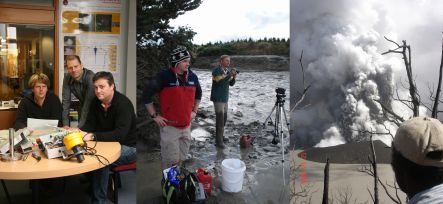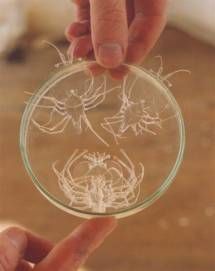Our Changing World for Thursday 26 November 2009
Entomologist John Early
 Auckland Museum's entomology collection contains about 300,000 specimens, amassed over 160 years. Keeping a watchful eye over everything is curator John Early, an entomologist who is passionate about all insects, but especially his beloved parasitic wasps. Alison Ballance visited John Early at the museum to talk about his recent book, and take a look at some of the specimens in the collection, and while she was there she also got to meet some live insects.
Auckland Museum's entomology collection contains about 300,000 specimens, amassed over 160 years. Keeping a watchful eye over everything is curator John Early, an entomologist who is passionate about all insects, but especially his beloved parasitic wasps. Alison Ballance visited John Early at the museum to talk about his recent book, and take a look at some of the specimens in the collection, and while she was there she also got to meet some live insects.
Know Your New Zealand … Insects and Spiders - by John Early with photos by Don Horne; published 2009 by New Holland.
Volcanoes and Lahars part 1

Shane Cronin and colleagues in the office and out in the field (left image: Malcolm Wood)
Studying volcanic mudflows, otherwise known as lahars, can be a tricky business given that their timing and travel paths are unpredictable, the behaviour of the flow can change dramatically, and their high-energy nature can make the flows dangerous to scientific equipment and observers. However, a major focus of volcanologist Shane Cronin's work is on lahars, for example, the lahar that occurred at Mt Ruapehu in March 2007. But what exactly is a lahar? It's a question that Shane Cronin and his colleagues from Massey University have been struggling over.
In this two part story, Ruth Beran visits Shane Cronin (pictured middle and middle left) in his office at Palmerston North to talk about lahars, as well as Jon Proctor (pictured seated right) who has just finished his PhD on the topic. She also speaks with statistician Mark Bebbington about historic eruptions in the Auckland volcanic field, and with Gert Lube (pictured seated left) and Natalia Pardo, two scientists working in Shane Cronin's team, who are both looking at the physical characteristics of very explosive eruptions such as pyroclastic flows. Understanding how these volcanic flows occur may help to predict future eruptions, and protect people not only here in New Zealand, but also in other parts of the world, like Columbia.
This article (pdf) provides more information about Shane Cronin and his work.
Volcanoes and lahars - part 2

Shane Cronin and colleagues in the office and out in the field (left image: Malcolm Wood)
Studying volcanic mudflows, otherwise known as lahars, can be a tricky business given that their timing and travel paths are unpredictable, the behaviour of the flow can change dramatically, and their high-energy nature can make the flows dangerous to scientific equipment and observers. However, a major focus of volcanologist Shane Cronin's work is on lahars, for example, the lahar that occurred at Mt Ruapehu in March 2007. But what exactly is a lahar? It's a question that Shane Cronin and his colleagues from Massey University have been struggling over.
In this two part story, Ruth Beran visits Shane Cronin (pictured middle and middle left) in his office at Palmerston North to talk about lahars, as well as Jon Proctor (pictured seated right) who has just finished his PhD on the topic. She also speaks with statistician Mark Bebbington about historic eruptions in the Auckland volcanic field, and with Gert Lube (pictured seated left) and Natalia Pardo, two scientists working in Shane Cronin's team, who are both looking at the physical characteristics of very explosive eruptions such as pyroclastic flows. Understanding how these volcanic flows occur may help to predict future eruptions, and protect people not only here in New Zealand, but also in other parts of the world, like Columbia.
Lobster Larvae
 In this week's Leigh Marine Laboratory story, Alison Ballance talks with the University of Auckland's Andrew Jeffs and Shane Lavery about crayfish, or lobster, larvae (image at right by John Booth). The tiny larvae head up to 200 kilometres offshore for the first 18 months of their life, and then manage to make their way back to shore to settle on rocky reefs. Andrew Jeffs is investigating what lobster larvae eat while they're out at sea, and has had to call on molecular biologist Shane Lavery who is bringing DNA finger-printing technology to help solve the mystery.
In this week's Leigh Marine Laboratory story, Alison Ballance talks with the University of Auckland's Andrew Jeffs and Shane Lavery about crayfish, or lobster, larvae (image at right by John Booth). The tiny larvae head up to 200 kilometres offshore for the first 18 months of their life, and then manage to make their way back to shore to settle on rocky reefs. Andrew Jeffs is investigating what lobster larvae eat while they're out at sea, and has had to call on molecular biologist Shane Lavery who is bringing DNA finger-printing technology to help solve the mystery.